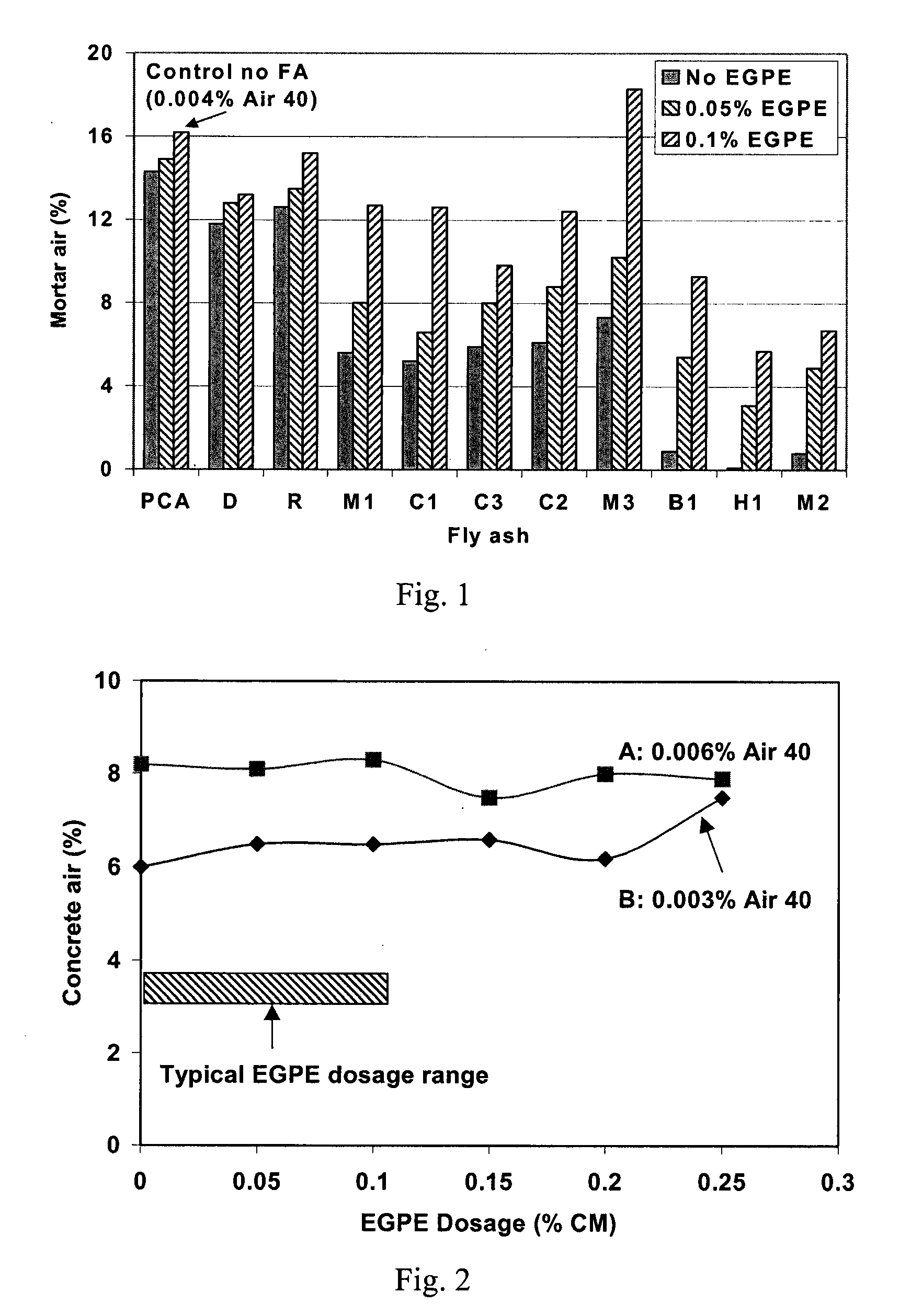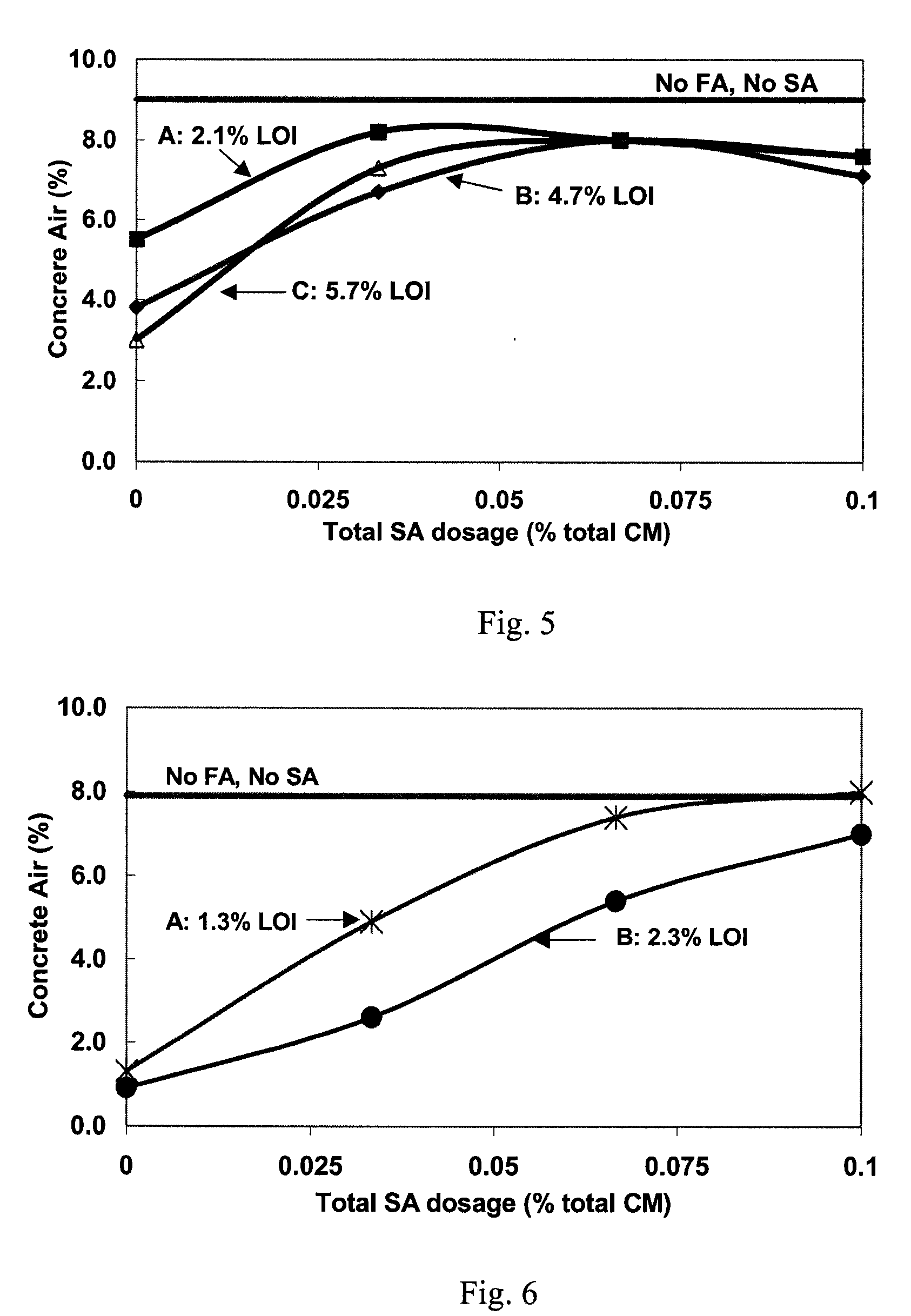Sacrificial Agents for Fly Ash Concrete
a technology of fly ash and concrete, applied in the field of sac, can solve the problems of entrapped air providing no protection, negative influence on bleed characteristics, and other challenging problems encountered when using certain fly ash, and achieve the effect of facilitating the spraying procedure and reducing the beneficial effect of sacrificial agents
- Summary
- Abstract
- Description
- Claims
- Application Information
AI Technical Summary
Benefits of technology
Problems solved by technology
Method used
Image
Examples
example 1
[0212]Adsorption (wt % Adsorbed) of sacrificial agents or air entrainment agents in slurries containing 10 wt % PCA cement or fly ash at pH 12.5 and Precipitation (wt % precipitated) in solutions extracted from slurries containing 10 wt % PCA cement or fly ash at pH 12.5; initial concentrations: sacrificial agents (3 mM), Air 30 and Air 40 (0.105 wt %).
Entries in parentheses: % precipitation when reacted with solutions extracted from the fly ash slurries (Results in Table 5).
TABLE 5LOIFly Ash(%)BAEGPENANDNSAir 30Air 40PCA3 (1)79 (79)73 (74)R0.2124 (0) 64 (52)65 (24)D, class C0.2559 (1) 84 (9) 69 (13)N0.3016 (11) 1 (0)20 (0) 26 (0)5 (0)M10.3513 (11) 4 (1)90 (80)27 (0)11 (0) 70 (59)70 (67)C1, class C1.6225 (11)12 (0)61 (0) 84 (31)70 (10)89 (32)76 (25)C23.3220 (14) 6 (0)4 (0)17 (0)5 (0)B14.3625 (12)12 (0)9 (0)14 (0)8 (0)25 (7) 46 (19)M25.3423 (15)14 (0)9 (0)13 (0)8 (0)18 (7) 30 (4) M311.3323 (13)14 (0)12 (0) 18 (0)10 (0) 55 (7) 66 (0)
[0213]As can be noted from the data in Table 5, a ...
example 2
[0235]Air entrained (vol %) in PCA cement paste containing 0.1 wt % (Table 6, col. 1) and 0.0125 wt % (Table 6, col. 2) air entrainment agents (Air 30 or Air 40) or selected sacrificial agents alone measured under ‘Minimum air’ and ‘Maximum air’ protocols (Results in Table 6).
TABLE 6Column12Minimum air protocolMaximum air protocol0.1% SA or AEA0.0125% SA or AEAAir 3046Air 4049BA01NA00ND37EGPE01NS02
[0236]In comparison to the air entrained by the air entrainment agents (Air 30 and Air 40) in the cement pastes, the sacrificial agents alone do not entrain air significantly, except for sodium di-isopropyl naphthalene sulfonate. Comparison of the air entrainment results further distinguishes the sacrificial agents of the present invention from conventional surfactants and air entrainment agents.
example 3
[0237]Air entrained (vol %) in 50:50 fly ash:PCA cement paste by 0.1 wt. % Air 30 alone and by 0.05 wt % sacrificial agents together with 0.1% Air 30 (Minimum air protocol) (Results in Table 7).
TABLE 7Fly ashLOI (%)Air 30+BA+NA+ND+EGPE+NSR0.21954356D0.251556356M10.353116554C11.6241454512B14.36354444M25.34744443M311.33645444Ave. (%)775445RSD (%)635718181354
[0238]As noted in preceding sections in the Example above, air entrainment in FA-cement (50:50) pastes, using a conventional AEA, exhibits high variability: Air 30 alone (0.1 wt %) entrains an average of 7% air in the different FA-cement pastes, with a relative standard deviation of 63%.
[0239]In combination with most of the sacrificial agents, Air 30 entrained somewhat less air on the average, but the RSD was reduced considerably in many cases; the reduction in RSD was particularly important with 1-naphthoic acid, sodium di-isopropyl naphthalene sulfonate and ethylene glycol phenyl ether, with RSD values less than 20%.
[0240]An addi...
PUM
| Property | Measurement | Unit |
|---|---|---|
| molecular weights | aaaaa | aaaaa |
| molecular weights | aaaaa | aaaaa |
| pH | aaaaa | aaaaa |
Abstract
Description
Claims
Application Information
 Login to View More
Login to View More - R&D
- Intellectual Property
- Life Sciences
- Materials
- Tech Scout
- Unparalleled Data Quality
- Higher Quality Content
- 60% Fewer Hallucinations
Browse by: Latest US Patents, China's latest patents, Technical Efficacy Thesaurus, Application Domain, Technology Topic, Popular Technical Reports.
© 2025 PatSnap. All rights reserved.Legal|Privacy policy|Modern Slavery Act Transparency Statement|Sitemap|About US| Contact US: help@patsnap.com



